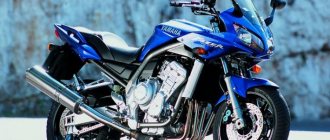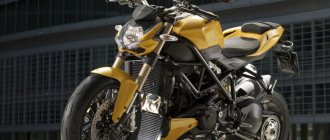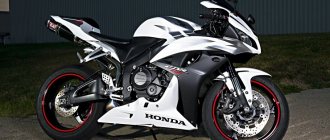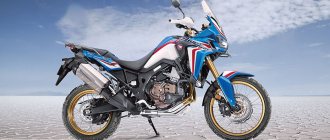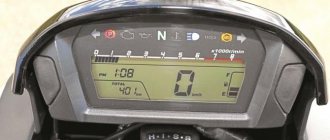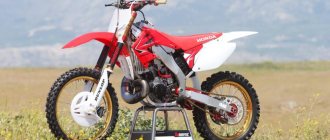— Honda motorcycle model
The Honda CBR600RR sports motorcycle model was introduced in 2003 in the image and likeness of the racing version RC211V, incorporating the advanced racing technologies used in MotoGP at that time - Unit Pro-Link rear suspension and electronic fuel injection with dual injectors (PGM-DSFI). . As the Honda CBR600RR model developed, it received more and more improvements and modifications to make the motorcycle lighter, increase maximum power and improve handling. This motorcycle is one of the flagships of the Honda sports motorcycle line.
The Honda CBR600RR is powered by an inline 4-cylinder liquid-cooled engine that produces 120 hp. power and 66 Nm of torque. The motor is configured to operate in the upper operating range and shows maximum performance at 11,000-13,000 rpm. This engine was also installed on the Honda CB600F Hornet (since 2007), Honda CBF 600 (since 2007) and Honda CBR600F (since 1999).
Features of the Honda CBR 600 RR include a rigid aluminum frame, adjustable sports suspension, radial brakes with a combined ABS system (optional), an electronic steering damper and 155 kg of dry weight.
Symptoms of engine repair on a Honda CBR 600 RR are:
- Extraneous noise in the engine
- High oil consumption
- Coolant flow
- Low compression in the engine or large difference between cylinders
- Excessively high compression associated with carbon deposits in the combustion chamber
- Blue smoke from the muffler
- Obvious oil leak from the engine
- Transmission problems
- Disassembly of Honda CBR 600 RR for engine removal
- Removing the Honda CBR 600 RR engine
- Cleaning the engine before disassembly
- Disassembling the motor
- Complete engine troubleshooting
- Cleaning the engine from metal shavings and other contaminants
- Diagnosis of all engine bearings and gears
- Replacement of worn/broken/bent parts
- Engine assembly
- Checking valve clearances
- Engine installation on a Honda CBR 600 RR
- Final assembly of Honda CBR 600 RR, launch
- All engine repair work is carried out by a highly qualified mechanic with extensive experience. A 1 year guarantee is provided for all work performed.
Stages of work on repairing the Honda CBR 600 RR engine:
Speculation has now turned to experimentation and we have seen that the 2009 CBR600RR C-ABS is simply amazing! Some motorcycles, such as the Gold Wing, ST1300 and VFR, simply use a twin or combined ABS system. Here the system is completely new. 2009 Honda CBR600RR C-ABS From what I heard when I asked Millar Farewell, Honda Americas' assistant director of technical training, the CBR system may soon be available on tourers or sport tourers. Overall, it's not like the CBR system has been optimized for sportbikes. However, the newest C-ABS is simpler, smarter, faster and lighter than the existing system, so Honda is likely to use this option on different models. ABS 101 The optional C-ABS on the CBR600RR will only be available in metallic black or red/black models. ABS models will also have bronze calipers. Standard caliper models will be black. Imagine a traditional braking system. When you apply the brake, fluid is sent directly from the brake cylinder to the caliper. Braking distance depends on the pressure applied to the lever or pedal. Conventional ABS consists of the following components: wheel speed sensors, control valves and a control unit (ABS brain). In the presence of ABS, brake fluid does not flow directly from the lever/pedal to the caliper, but first passes through the control valve and then to the corresponding caliper. That is, everything is the same as a conventional system, only there is one more additional path through the control valve. The role of the control unit is to monitor the speed of the wheels through sensors located on each wheel and registering unusually rapid deceleration. The ABS control unit knows, based on the parameters programmed into it, that at some stage of braking the wheel will lock. And before this happens, the electronic control device closes the control valve, thereby reducing the pressure enough to prevent the wheel from stopping rotation. Next, the control unit opens the control valve again, increasing the pressure and thus creating another attempt to brake. The basic idea of ABS is that the control unit acts as an intermediary between the control valves and the brake caliper, acting in accordance with wheel speed, opening and closing valves to reduce or increase fluid pressure. Moreover, ABS usually works faster than the wheel can significantly change speed, going through the cycle in 1/15 of a second. Often the ABS also uses a pump to restore brake fluid pressure, as well as some other components. If there is ABS here, it's Honda's C-ABS Honda, with its new C-ABS, planned to achieve four main goals: • Make immediate and full use of the braking system possible • Maintain stability during braking • Reduce chassis response to ABS operation • Increase the rider's confidence that no wheel will be locked Honda reminds us that traditional ABS and combined ABS on motorcycles use additional components such as a delay valve, a pressure control valve, a fork-mounted second master cylinder and special 3-piston brake calipers. What makes this new system special is that Honda was able to eliminate these additional bulky components by using a traditional caliper. In the case of the 2009 CBR600RR (regardless of whether it has a standard brake or C-ABS), that traditional caliper is now essentially the same radial-mount caliper as the CBR1000RR. Nice modernization. Here we can see the rear power component, one of the few visible parts of the C-ABS. The five components that make up the new C-ABS are located on the motorcycle in mass centralized areas. One of the key challenges with C-ABS in CBR models is their short wheelbase and high center of gravity. As you've probably seen at races, or even know from experience, grabbing the front brake of a modern sportbike instantly lifts the rear wheel into the sky. C-ABS significantly reduces unwanted chassis movement during heavy braking. To maintain Honda's sportbike mass centralization philosophy, C-ABS components have been placed where they will not negatively impact the bike's handling. Despite all the efforts, one minor change had to be made: moving the shock reservoir to the beam on the left side of the subframe to provide room for the rear powerplant. You're probably already wondering how much extra weight the C-ABS CBR600RR carries. The system added about 10 kg to the 185 kg curb weight of the model without C-ABS. Honda did what other manufacturers do: it bought competitors' motorcycles. According to Honda, the gross weight of Japanese supersports in 2009 was: • CBR600RR without C-ABS – 185 kg, with C-ABS – 195 kg • Kawasaki ZX-6R – 193 kg (according to Kawasaki -189) • Suzuki GSX-R600 – 195 kg (according to Suzuki - 194) • Yamaha R6 - 190 kg (according to Yamaha - 186) In addition to the fact that any anti-lock braking system requires wheel speed sensors and a pulse generator, combined C-ABS on both the CBR 600 and The 1000th model consists of one power unit (modulator) and one valve for each wheel, and, of course, an control unit module (ECM). The heart of C-ABS. A pair of power units are at the bottom in the photo, a pair of hydraulic valves are at the top, and the ECM is in the center. Each wheel has one power unit and one hydraulic valve, and the ECM performs control functions. Forget about ABS for a minute, just watch how this new system works. When you apply the front brake lever or rear brake pedal, fluid from the corresponding master cylinder flows to the hydraulic distributor, where pressure sensors transmit information to the ECM about the amount of pressure applied. Next, the ECM transmits a signal to the power plant. The power unit is a ball screw connected to the transmission that drives a piston (think of it like a piston in the master cylinder) to pressurize the brake fluid. After this, the fluid leaves the power unit back through the hydraulic distributor and then into the caliper. New C-ABS for dummies: from the brake lever to the hydraulic distributor; the hydraulic distributor signals the ECM; The ECM sends a signal to the powertrain; The power plant pumps pressure back through the hydraulic distributor and further to the caliper. That's it, stop. Now, if you think about this system and realize that when you squeeze the lever, you are not putting direct pressure on the caliper, then you are probably wondering, how is that possible? Or maybe you feel the same way with the traditional system. Inside the hydraulic valve there is a so-called electronic shock simulator. It consists of two “rubber buffers of different densities, which return increased resistance (to the lever or pedal) when braking.” It's like a brake lever simulator. So how did Honda fit that real, conventional brake feel between two tiny pieces of rubber? Only the Japanese company's employees have a clear understanding of this, but it is known that former professional racers Jeff Tigert and Doug Toland, among others, were involved in the work to evaluate and simulate the feel of a conventional brake. They both spent countless hours at Honda developing the bikes, and as Farewell said, "When you're behind the wheel of a CBR with C-ABS, it's like some part of Doug and Jeff is riding with you." And that's very encouraging, especially if you've seen how fast these two drivers go lap after lap. The brake fluid and ECM path in this diagram should help you understand how the new brake system works in the Honda. Linked, combined... Electrical brake control? The use of the word “combined” instead of “associated” is noteworthy, and here’s why. On the Gold Wing, for example, when you squeeze the brake lever, fluid pressure will actuate the two outer pistons in each three-piston front caliper. With increasing pressure and using the aforementioned delay valves, second master cylinder, etc., fluid will flow through the "proportional valve control" (PVC) to the rear caliper, activating it as well. Full set. Shown here is the location of each of the five main components that make up C-ABS. Honda has made a slight redesign of the exterior to accommodate the electronics in the braking system. Likewise, when the rear brake is applied, fluid pressure will be redirected through the PCV, first to the left front caliper middle piston, and then, as pressure increases, to the right front caliper middle piston. That's all! They are connected! It is a completely mechanical system, and as a precaution, it is designed so that if one part of the system fails, the other will continue to function. Moreover, this system is independent of ABS. Since the brakes are hydraulically coupled, it is a true “linked” system. With this new combined system there is absolutely no mechanical connection between the front and rear. And coordination of the brakes lies entirely with the electronic module. Therefore, the ECM not only regulates the pressure in each brake system, but can also “combine” the front and rear brake systems based on the set parameters. Consequently, this is the first electrically controlled brake system available on a commercial sportbike. An electronic shock simulator hidden in the hydraulic valve gives the pilot the feel of a normal brake. Sectional view of the hydraulic distributor. Sectional view of the power plant. The modulator piston shown creates fluid back pressure through the hydraulic valve to the calipers. According to Farewell, the updated ECM in the C-ABS system responds 3 times faster than the ECM in the VFR. The new system should react faster due to the fact that in modern supersport everything happens so quickly. In addition, thanks to the smooth anti-lock activation, the rider hardly feels it until the last meters before stopping, a barely noticeable vibration from the chassis appears. And that's because the bike has slowed down to a speed where you can already feel some kind of response. This perception is so minimal that it will likely go unnoticed by most riders. Well, is there skepticism about a computer thinking for you? This fail-safe system defines C-ABS as “all or nothing.” If an error is detected at any point in the self-test, the entire C-ABS will essentially shut down, opening all the valves and turning into a traditional non-ABS braking system. Also don't forget that this system is made for super sports and is much less intrusive than one might think. Unlike some modern ABS on BMW motorcycles, Honda's C-ABS cannot be disabled manually. When the system sees that you are slamming on the brake lever in a desperate attempt to stop, the braking will be applied partially to the rear brake, in proportion to the pressure on the front brake, regardless of ABS activation. It would be possible to try this on a conventional braking system, but most riders do not have the necessary skills to match the speed and precision of an electronic system. Applying the rear brake will compress the rear suspension, which will help stabilize the chassis, achieving one of the main purposes of C-ABS in a supersport. When only the rear brake is applied, the ECM does not apply the front brake until the rear brake is close to locking the wheel. This, according to Farewell, distinguishes this system from a conventional system in which the front brake is applied much earlier. The rider can now use the rear brake as a non-combined system. This can be very useful, for example, during sports competitions. Enough words So that Honda can prove to the world how special this new C-ABS is, American motorcycle journalists were invited to the company's North American research and development division, located somewhere in the desert lands of Mojave (California). The security service is impressive. After passing through the checkpoint with a security escort straight to my destination, I felt as if I was no longer on American soil... Testing of the motorcycle will take place on what Honda calls the Wind Road, a 7.2 km loop created in the first place , for checking cars. This location simulates real-life conditions. There are climbs, turns of different radii, surfaces with different surfaces, drawn lines and specially placed potholes and convex bumps. Braking a CBR with C-ABS from 160 km/h in water with the brakes fully applied. Pay attention to the distance between the front fender and the upper deflector, as well as how tightly the fork is compressed. Braking is smooth all the way. What would be the ideal test situation for an ABS package? What about a naturally slippery surface after two days of rain? Several days of rain in a row are an anomaly in this area of Mojava. After observing one or two circles, we began to think. Despite the potential of the new C-ABS, my experience of hundreds of thousands of kilometers on wet roads without ABS has programmed my brain to avoid hard braking in such conditions. However, Honda experts assured us that whenever we are ready to abandon stereotypes and forget about self-preservation, the new C-ABS will welcome us with open arms. It rained on the day of our race, providing unique circumstances for testing the new ABS. Otherwise it probably wouldn't be so fun. We weren't there to criticize the bike's power and handling as usual, so high speed wasn't a priority for me. However, when a turn or climb approached, I would squeeze the front brake as hard as I could convince myself to do so. Without ABS, the CBR1000RR type calipers give the excellent feeling of very smooth operation of the brake discs. Anyone who buys a 2009 CBR600RR without the optional C-ABS will still be rewarded with great brakes. My report on ABS on the road is that it works exactly as advertised. There is absolutely no pulsation, which is usually present in many anti-lock systems and feeds back into the lever or pedal. Here you can only feel the slightest vibration in the last few meters before coming to a complete stop. The system is simple and surprisingly smooth. Driving through the skid test site, one of my colleagues had the audacity to suggest specially flooding the site with water in addition to what had already rained from the sky. Stupid? Maybe. Is the CBR completely safe and controllable with C-ABS? Absolutely! A few cm of water, a little mud, sand, gravel, and the route with painted lines becomes a very dangerous emergency area. Reaching speeds of about 160 km/h in a very short period and braking hard, the motorcycle stops in a way that it would not have stopped before on less wet surfaces. C-ABS provides better braking in this situation. In fact, in this rainy environment it was clear to see how the ABS worked. The deceleration and acceleration of the rear wheel was felt well. Still, although the situation was practically an emergency, I felt a certain confidence. Best supersport brakes? So this system works incredibly well. Of course, it's too early to tell until we've seen other players in the arena, but I'm willing to bet the 2009 Honda CBR600RR's C-ABS has the best brakes in the class. With my driving and braking experience, if I were buying a CBR600RR, I would get it with C-ABS. The suggested retail price for the model without C-ABS is $9,799, and with C-ABS it is $10,799. Additional Information on the 2009 CBR600RR • More midrange has been added to torque peaks at 10,000 rpm, said to be noticeable from 4,000 to 12,000, according to American Honda's John Seidel. • This increase in torque is achieved while the exhaust manifold connecting pipe and exhaust valve have the same pressures as the 1000RR. This pressure valve opens above 8,000 rpm in first and second gears, or above 6,000 in third to sixth gears. Additional tuning includes surface treatment of the intake pipes for better power and torque. • The exterior has been updated, mainly to accommodate C-ABS components, but the changes are subtle. As a result, Honda's design became a little more modern. • The 2009 model is available in 5 color options: Black Metallic, Red/Black, Black/Bright Green Metallic, special Phoenix graphics, and Pearl White/Pearl Blue/Red, available on only 500 units. Please note that C-ABS will only be available on metallic black and red/black models. In addition, models with C-ABS will stand out with bronze calipers on a black background. • For those who have not yet understood, C-ABS is an electronic nanny for braking and acceleration. • C-ABS in the CBR600RR should already have dealers, and the 1000th model will appear in the near future. However, Honda realized that due to the features of the CBR market, they did not have to expect a great demand for the model with C-ast of C-ast of ... so far. No exact numbers about the number of motorcycles with C-Abs supplied by the United States were announced. • By the way, the rest of the manufacturers are not very far behind. Yamaha is probably the closest to the launch of your version of the ABS for a sports woman. It just happened that Honda brought its new system to the market earlier than anyone.
Valve adjustment Honda CBR 600 RR
Check the valve thermal clearances according to the service manual for your Honda CBR 600 RR, as well as after disassembling the head or replacing the timing chain or when a characteristic “clunking noise” appears from the cylinder head.
Increased valve clearances lead to increased noise when the engine is running, and if the clearances are too small, the valves will not close, and the engine will not develop rated power, and sometimes it will be difficult to start.
Our service center provides:
Please note that after adjusting the valves, in some cases it is necessary to synchronize the carburetors.
Model history
2003 – start of production and sales. First generation. Model: Honda CBR600RR (all markets). Model code: CBR600RR3.
2004 - no significant changes. Model: Honda CBR600RR (all markets). Model code: CBR600RR4.
2005 - restyling of the model. Second generation. New frame, swingarm and rear shock. New radial calipers. New 41mm inverted fork (instead of the usual 45mm). Curb weight is reduced from 199 to 189 kg. Model: Honda CBR600RR (all markets). Model code: CBR600RR5.
2006 - no significant changes. Model: Honda CBR600RR (all markets). Model code: CBR600RR6.
2007 - restyling of the model. Third generation. New engine (lightened, many internal components rebuilt), maximum power increases: 117 → 118 hp. New lightweight frame. The wheelbase is reduced: 1395 → 1370 mm. The model receives an electronic steering damper. Model: Honda CBR600RR (all markets). Model code: CBR600RR7.
2008 - no significant changes. Model: Honda CBR600RR (all markets). Model code: CBR600RR8.
2009 - minor changes to the engine (pistons, cylinder head, exhaust). Maximum power increases: 118 → 120 hp. The appearance of versions of the Honda CBR600RA with a combined braking system + ABS. Model: Honda CBR600RR + ABS (all markets). Model code: CBR600RR9 + CBR600RA9.
2010 - no significant changes. Model: Honda CBR600RR + ABS (all markets). Model code: CBR600RRA + CBR600RAA.
2011 - no significant changes. Model: Honda CBR600RR + ABS (all markets). Model code: CBR600RRB + CBR600RAB.
2012 - no significant changes. Model: Honda CBR600RR + ABS (all markets). Model code: CBR600RRC + CBR600RAC.
2013 - restyling of the model. Fourth generation. The model receives new ECU settings, a new Showa Big Piston front fork and other rear suspension settings. Model: Honda CBR600RR + ABS (all markets). Model code: CBR600RRD + CBR600RAD.
2014 - no significant changes. Model: Honda CBR600RR + ABS (all markets). Model code: CBR600RRE + CBR600RAE.
2015 - no significant changes. Model: Honda CBR600RR + ABS (all markets). Model code: CBR600RRF + CBR600RAF.
2016 - no significant changes. Model: Honda CBR600RR + ABS (all markets). Model code: CBR600RRG + CBR600RAG.
2017 - no significant changes. Model: Honda CBR600RR + ABS (all markets). Model code: CBR600RRH + CBR600RAH.
2018 - no significant changes. Model: Honda CBR600RR + ABS (all markets). Model code: CBR600RRJ + CBR600RAJ.
CBR600RR (2003-2004) CBR600RR (2005-2006) CBR600RR (2007-2008) CBR600RR (2009-2012) CBR600RR (2013-present)
Honda CBR 600 RR clutch repair and replacement
One of the most important mechanisms of the Honda CBR 600 RR is the clutch. Although this is a fairly simple structural element, it has an important task. The operation of the clutch is based on the frictional force between its discs. The torque of the motor is transmitted to the driven parts, which in turn transmit the torque of the gearbox.
The need for clutch repair in Moscow is dictated by various factors, among which are intensive operating conditions. In addition, repair of the Honda CBR 600 RR clutch is in demand in case of planned wear of its individual elements.
Common Honda CBR 600 RR clutch faults
Clutch repair or maintenance involves the following work:
Diagnostics and replacement of timing chain, repair of timing chain tensioner Honda CBR 600 RR
Quite often, a malfunction of the Honda CBR 600 RR timing chain is caused by an increase in the pitch between the links. As a result, the engine begins to idle incorrectly. Therefore, it is not at all surprising that the chain begins to jump several teeth at the same time. What does this mean? Firstly, the engine will stall. Secondly, the valves may be jammed. This, in turn, may require expensive engine repairs. Therefore, when the first signs of malfunction are detected, it is recommended to replace the timing chain on the Honda CBR 600 RR.

